[spring]spring详细总结
spring
1.spring简介
Spring框架是一个开源的应用程序框架,是针对bean的生命周期进行管理的轻量级容器。
Spring解决了开发者在J2EE开发中遇到的许多常见的问题,提供了功能强大IOC、AOP及Web MVC等功能。
Spring可以单独应用于构筑应用程序,也可以和Struts、Webwork、Tapestry等众多Web框架组合使用,并且可以与 Swing等桌面应用程序AP组合。
Spring不仅仅能应用于J2EE应用程序之中,也可以应用于桌面应用程序以及小应用程序之中。
Spring框架主要由七部分组成,分别是 Spring Core、 Spring AOP、 Spring ORM、 Spring DAO、Spring Context、 Spring Web和 Spring Web MVC。
官方文档地址:
https://docs.spring.io/spring-framework/docs/4.3.9.RELEASE/spring-framework-reference/
中文
https://www.docs4dev.com/docs/zh/spring-framework/5.1.3.RELEASE/reference/
优点:
- 开源免费
- 轻量级的非入侵式的
- 控制反转(IOC),面向切面编程(aop)
- 支持事务处理
使用spring的jar包支持:
<!-- https://mvnrepository.com/artifact/org.springframework/spring-web -->
<dependency>
<groupId>org.springframework</groupId>
<artifactId>spring-web</artifactId>
<version>5.3.22</version>
</dependency>
七大模块:
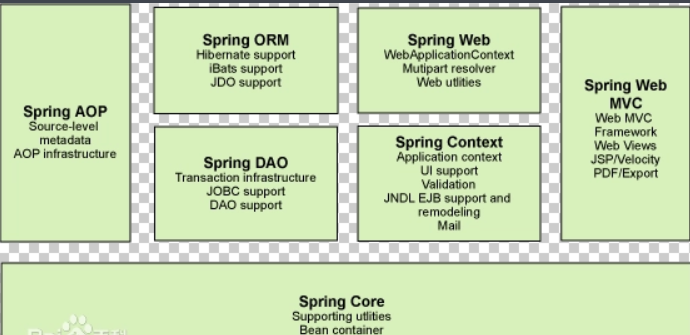
弊端:发展了太久后,配置越来越多,人称“配置地狱”
2.IOC理论推导
在我们之前的业务中,用户的需求可能会影响程序的代码,可能需要修改代码,如果程序的代码量十分大,修改一次的成本十分的昂贵!
原来的方式:
private UserMapper usermapper=new UserMapperImpl();
现在将对象的传递由new变成set动态注入
private UserMapper userMapper;
public void setUserMapper(UserMapper userMapper){
this.userMapper=userMapper;
}
原来是程序控制的,现在变成用户控制了。
3.一个spring项目的快速搭建
(1)写一个实体类
package com.pojo;
/**
* @author panglili
* @create 2022-07-23-21:40
*/
public class HelloSpring {
private String name;
public void setName(String name) {
this.name = name;
}
public String getName() {
return name;
}
@Override
public String toString() {
return name;
}
}
(2)将实体类配置在spring容器
<?xml version="1.0" encoding="UTF-8"?>
<beans xmlns = "http://www.springframework.org/schema/beans"
xmlns:xsi = "http://www.w3.org/2001/XMLSchema-instance"
xsi:schemaLocation = "http://www.springframework.org/schema/beans
http://www.springframework.org/schema/beans/spring-beans.xsd" >
<!--使用spring来创建对象,在spring中被称为bean -->
<!-- class="com.pojo.HelloSpring" 相当于在newHelloSpring
id="helloSpring" 相当于对象变量名字
name="name" 属性
value="spring" 属性值
-->
<bean id="helloSpring" class="com.pojo.HelloSpring">
<property name="name" value="spring"></property>
</bean>
</beans>
(3)测试
import com.pojo.HelloSpring;
import org.springframework.context.ApplicationContext;
import org.springframework.context.support.ClassPathXmlApplicationContext;
/**
* @author panglili
* @create 2022-07-23-21:43
*/
public class MyTest {
public static void main(String[] args) {
ApplicationContext context = new ClassPathXmlApplicationContext( "application.xml");
HelloSpring hello =(HelloSpring) context.getBean("helloSpring");
System.out.println(hello.toString());
}
}
4.IOC创建对象的过程
- 使用无参构造创造
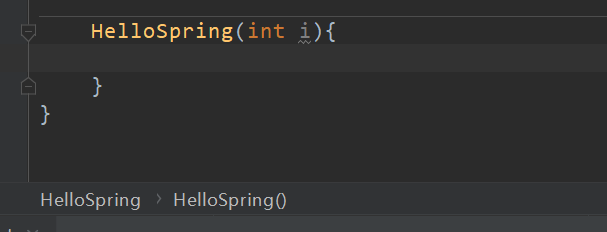
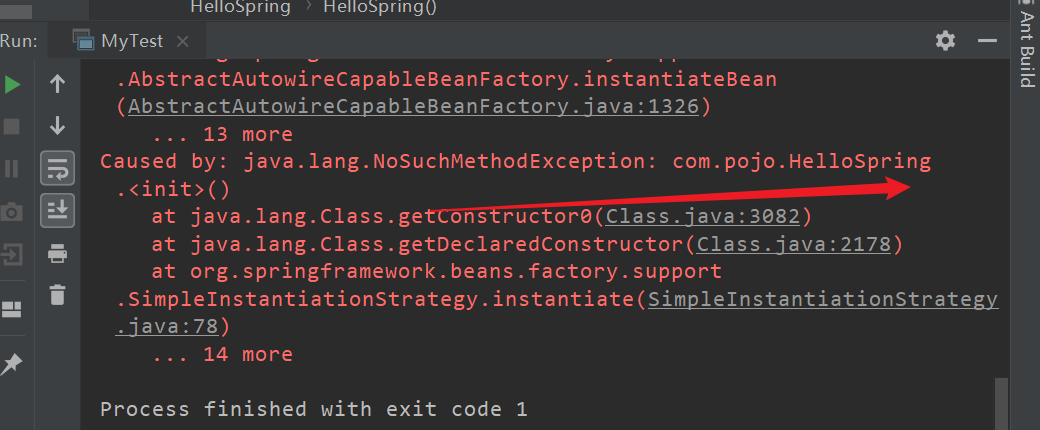
设定为有参后,就会报错!
对象在被注册进去的时候,就被实例化了,直接使用就好。
5.IO注入
(1)前面的构造器注入
(2)set注入
<?xml version="1.0" encoding="UTF-8"?>
<beans xmlns="http://www.springframework.org/schema/beans"
xmlns:xsi="http://www.w3.org/2001/XMLSchema-instance"
xsi:schemaLocation="http://www.springframework.org/schema/beans
https://www.springframework.org/schema/beans/spring-beans.xsd">
<bean id="user" class="cn.itnanls.User">
<!--构造注入——参数类型注入-->
<!--<constructor-arg type="java.lang.Integer" value="12"/>-->
<!--<constructor-arg type="java.lang.String" value="Tom"/>-->
<!--构造注入——下标注入-->
<!--<constructor-arg index="0" value="tom"/>-->
<!--<constructor-arg index="1" value="12"/>-->
<!--构造注入——名字注入,最常用-->
<!--<constructor-arg name="name" value="lucy"/>-->
<!--<constructor-arg name="age" value="12"/>-->
<!--setter注入-->
<!--<property name="name" value="tom"/>-->
</bean>
</beans>
构造注入对象之间的关系为组合
set注入的对象之间的关系为聚合
(3)p命名空间注入
- 使用set方式注入
<beans xmlns = "http://www.springframework.org/schema/beans"
xmlns:xsi = "http://www.w3.org/2001/XMLSchema-instance"
xmlns:p = "http://www.springframework.org/schema/p"
xsi:schemaLocation = "http://www.springframework.org/schema/beans
http://www.springframework.org/schema/beans/spring-beans.xsd" >
<bean id="helloSpring" class="com.pojo.HelloSpring">
<property name="name" value="spring"></property>
</bean>
<bean id="p-name" class="com.pojo.HelloSpring" p:name="ss">
</beans>
(4)c命名空间注入
- 使用构造器方式注入,开启构造器才能用
HelloSpring(String name){
this.name=name;
}
HelloSpring(){
}
<bean id="c-name" class="com.pojo.HelloSpring" c:name="cName"/>
注意导入头文件
xmlns:p = "http://www.springframework.org/schema/p"
xmlns:c="http://www.springframework.org/schema/c"
6.作用域
ScopeDescription
(Default) Scopes a single bean definition to a single object instance for each Spring IoC container.
Scopes a single bean definition to any number of object instances.
Scopes a single bean definition to the lifecycle of a single HTTP request. That is, each HTTP request has its own instance of a bean created off the back of a single bean definition. Only valid in the context of a web-aware Spring ApplicationContext.
Scopes a single bean definition to the lifecycle of an HTTP Session. Only valid in the context of a web-aware Spring ApplicationContext.
Scopes a single bean definition to the lifecycle of a ServletContext. Only valid in the context of a web-aware Spring ApplicationContext.
Scopes a single bean definition to the lifecycle of a WebSocket. Only valid in the context of a web-aware Spring ApplicationContext.
- 单例
<bean id="accountService" class="com.DefaultAccountService"/>
*<!-- the following is equivalent, though redundant (singleton scope is the default) -->*
<bean id="accountService" class="com.DefaultAccountService" scope="singleton"/>
- 原型
<bean id="accountService" class="com.something.DefaultAccountService" scope="prototype"/>
7.bean的自动装配
- 是spring满足bean依赖的一种方式
- spring会在上下文中自动寻找,并自动给bean装配属性
spring的装配方式:
(1)手动装配
- 在people类中依赖了cat和dog对象,所以属性中手动装配他们的属性
<?xml version="1.0" encoding="UTF-8"?>
<beans xmlns = "http://www.springframework.org/schema/beans"
xmlns:xsi = "http://www.w3.org/2001/XMLSchema-instance"
xsi:schemaLocation = "http://www.springframework.org/schema/beans
http://www.springframework.org/schema/beans/spring-beans.xsd" >
<bean id="cat" class="pojo.Cat">
<property name="voice" value="mom~"/>
</bean>
<bean id="dog" class="pojo.Dog">
<property name="voice" value="wow~"/>
</bean>
<bean id="people" class="pojo.People">
<property name="name" value="tata"/>
<property name="dog" ref="dog"/>
<property name="cat" ref="cat"/>
</bean>
</beans>
(2)自动装配
通过byName自动装配
- spring会自动去找people中的set后面相对应的cat和dog与bean中id对应
<bean id="people" class="pojo.People" autowire="byName">
<property name="name" value="tata"/>
</bean>
通过byType自动装配
- spring会自动去找people中的对象依赖和bean中class类相同的对应
<bean id="people" class="pojo.People" autowire="byType">
<property name="name" value="tata"/>
</bean>
(3)使用注解实现自动装配
使用之前导入注解依赖的配置和支持
<?xml version="1.0" encoding="UTF-8"?>
<beans xmlns="http://www.springframework.org/schema/beans"
xmlns:xsi="http://www.w3.org/2001/XMLSchema-instance"
xmlns:context="http://www.springframework.org/schema/context"
xsi:schemaLocation="http://www.springframework.org/schema/beans
https://www.springframework.org/schema/beans/spring-beans.xsd
http://www.springframework.org/schema/context
https://www.springframework.org/schema/context/spring-context.xsd">
<context:annotation-config/>
</beans>
不再使用显示引用对象依赖的其他属性
<bean id="cat" class="pojo.Cat"/>
<bean id="dog" class="pojo.Dog"/>
<bean id="people" class="pojo.People"/>
@Autowired
直接在对象上面使用@Autowired注解
private String name;
@Autowired
private Dog dog;
@Autowired
private Cat cat;
如果装配环境复杂的话,可以通过@Qualifier(value = "cat")指定bean注入
例如多个cat对象bean,属性值不同的时候
<bean id="cat" class="pojo.Cat">
<property name="eat" value="fish"/>
</bean>
<bean id="cat11" class="pojo.Cat">
<property name="eat" value="cookie"/>
</bean>
就需要
@Qualifier
否则,只会spring会走第一个bean
@Autowired
@Qualifier(value = "cat11")
private Cat cat;
Resource
- 这个注解跟上面的@Autowired功能相似,但是它可以通过名字再通过类型装配,都没有才会报错,要比@Autowired智能一点,但使用较少。
@Resource(name="cat")
private Cat cat;
8.使用注解开发
1.bean
spring4以后,注解依赖于aop包,确保你的lib中有它
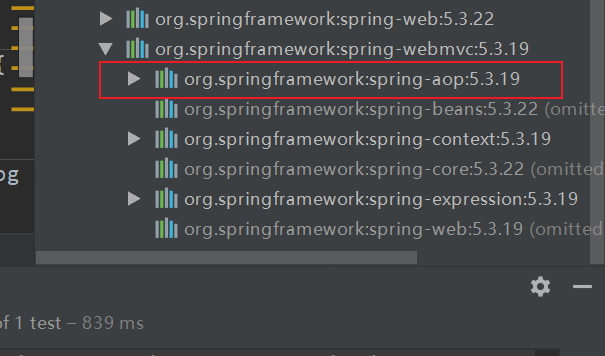
确保开启了使用注解
<context:annotation-config/>
2.组件代替bean实现自动注入
在配置文件中自动扫描包下的所有类为bean
<context:component-scan base-package="pojo"/>
在类对象上加上注解@Component可以被扫描
- @component (把普通pojo实例化到spring容器中,相当于配置文件中的 )
@Component
使用注解给属性注入值
package pojo;
import org.springframework.beans.factory.annotation.Autowired;
import org.springframework.beans.factory.annotation.Qualifier;
import org.springframework.beans.factory.annotation.Value;
import org.springframework.stereotype.Component;
import javax.annotation.Resource;
/**
* @author panglili
* @create 2022-07-24-9:52
*/
@Component
public class People {
private String name;
@Value("123")
public int age;
private Dog dog;
private Cat cat;
}
}
- 但是复杂的属性配置还是建议使用xml统一管理注入
3.component衍生的注解
dao:@repository
service:@service
controller:@controller
跟component功能相同只是能够使得分工更加的明确
小结:
xml与注解:
- xml更加万能,适用于各种场合!维护简单方便
- 注解 不是自己类使用不了,维护相对复杂
最佳实践:
- xml用来管理bean
- 注解只负责属性的注入
9.使用javaconfig实现代替xml配置
The central artifacts in Spring’s new Java-configuration support are @Configuration-annotated classes and @Bean-annotated methods.
根据官方文档的说明,创建一个java—configuration的配置类,使用@configuration注解,再使用@Bean在方法上面就可以实现xml中的功能。
(1)创建一个java—configuration
package config;
import org.springframework.context.annotation.Bean;
import org.springframework.context.annotation.Configuration;
import pojo.User;
/**
* @author panglili
* @create 2022-07-24-11:24
*/
@Configuration
public class Java_config {
@Bean
public User getUser(){
return new User();
}
}
(2)实体类
package pojo;
import org.springframework.beans.factory.annotation.Autowired;
import org.springframework.beans.factory.annotation.Value;
import org.springframework.context.annotation.Bean;
import org.springframework.stereotype.Component;
/**
* @author panglili
* @create 2022-07-24-11:24
*/
@Component
public class User {
@Value("tata")
private String name;
public String getName() {
return name;
}
public void setName(String name) {
this.name = name;
}
}
(3)测试
现在也可以拿到值
import config.Java_config;
import org.springframework.context.annotation.AnnotationConfigApplicationContext;
import pojo.User;
/**
* @author panglili
* @create 2022-07-24-11:28
*/
public class MyTest {
public static void main(String[] args) {
AnnotationConfigApplicationContext context = new AnnotationConfigApplicationContext(Java_config.class);
User user =(User) context.getBean("getUser");
System.out.println(user.getName());
}
}

这种java代替xml的实现方式,在springboot中大量使用。
10.代理模式
代理模式的分类:
- 静态代理
- 动态代理
关系分析
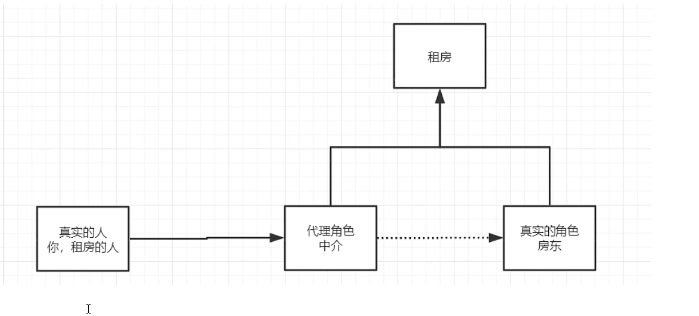
抽象角色:一般会使用接口或者抽象类
真实角色:被代理的角色
代理角色:代理真实的角色,做一些附属的操作
客户:访问代理对象的人
静态代理
步骤:
抽象角色:
/**
* @author panglili
* @create 2022-07-24-15:00
*/
public interface Rent {
public void rent();
}
真实角色:
/**
* @author panglili
* @create 2022-07-24-15:01
*/
public class Host implements Rent {
public void rent() {
System.out.println("host would rent house");
}
}
代理角色:
/**
* @author panglili
* @create 2022-07-24-15:02
*/
public class Proxy implements Rent {
private Host host;
public Proxy(){
}
public Proxy(Host host){
this.host=host;
}
public void rent() {
host.rent();
seeHouse();
}
//look house
public void seeHouse(){
System.out.println("look House");
}
}
客户:
/**
* @author panglili
* @create 2022-07-24-15:02
*/
public class Client {
public static void main(String[] args) {
Host host = new Host();
Proxy proxy = new Proxy(host);
proxy .rent();
}
}
动态代理
- 和静态代理的角色一样
- 动态生成,不是我们直接写好了的
- 动态代理分为两大类:基于接口的动态代理和基于类的动态代理
- 基于接口——jdbc
- 基于类——cglib
- 基于字节码
11.AOP切面编程
使用aop植入,需要导入一个依赖包
<dependency>
<groupId>org.aspectj</groupId>
<artifactId>aspectjweaver</artifactId>
<version>1.9.7</version>
</dependency>
- 横切关注点
- 切面
- 通知
- 目标
- 代理
- 切入点
- 连接点
在执行的方法前动态的添加一个日志输出
方法一使用spring类实现
(1)接口
package service;
/**
* @author panglili
* @create 2022-07-24-16:09
*/
public interface Service {
public void add();
public void delete();
public void update();
public void select();
}
(2)要代理的实现类
package service;
/**
* @author panglili
* @create 2022-07-24-16:09
*/
public class ServiceImpl implements Service {
public void add() {
System.out.println("add");
}
public void delete() {
System.out.println("delete");
}
public void update() {
System.out.println("update");
}
public void select() {
System.out.println("select");
}
}
(3)代理商
package log;
import org.springframework.aop.MethodBeforeAdvice;
import java.lang.reflect.Method;
/**
* @author panglili
* @create 2022-07-24-16:11
*/
public class Log implements MethodBeforeAdvice {
public void before(Method method, Object[] args, Object target) throws Throwable {
System.out.println("excutor"+method.getName()+target);
}
}
<!--注册bean -->
<bean id="userSer" class="service.ServiceImpl"/>
<bean id="log" class="log.Log"/>
<!--方式一:使用原生的spring api接口 -->
<aop:config>
<!-- 切入点expression要切入的位置-->
<aop:pointcut id="pointcut" expression="execution(* service.ServiceImpl.*(..))"/>
<!--执行环绕增加 -->
<aop:advisor advice-ref="log" pointcut-ref="pointcut"/>
</aop:config>
(4)客户调用
import org.springframework.context.ApplicationContext;
import org.springframework.context.support.ClassPathXmlApplicationContext;
import service.Service;
/**
* @author panglili
* @create 2022-07-24-16:28
*/
public class MyTest {
public static void main(String[] args) {
ApplicationContext context = new ClassPathXmlApplicationContext("application.xml");
//注意,代理的是接口类型
Service ser = (Service) context.getBean("userSer");
ser.add();
}
}
方法二 使用自定义类实现
(1)自定义一个类,是被横切进去的内容
package dir;
/**
* @author panglili
* @create 2022-07-24-17:00
*/
public class PointMethod {
public void after(){
System.out.println("执行方法之后切入……");
}
public void before(){
System.out.println("执行方法之前切入……");
}
}
(2)在配置文件中使用aop切入
<!--方式二 自定义类切入 -->
<bean id="in" class="dir.PointMethod"/>
<aop:config>
<!--自定义切面 -->
<aop:aspect ref="in">
<aop:pointcut id="point" expression="execution(* service.ServiceImpl.*(..))"/>
<aop:after method="after" pointcut-ref="point"/>
<aop:before method="before" pointcut-ref="point"/>
</aop:aspect>
</aop:config>
(3)测试
import org.springframework.context.ApplicationContext;
import org.springframework.context.support.ClassPathXmlApplicationContext;
import service.Service;
/**
* @author panglili
* @create 2022-07-24-16:28
*/
public class MyTest {
public static void main(String[] args) {
ApplicationContext context = new ClassPathXmlApplicationContext("application.xml");
//注意,代理的是接口类型
Service ser = (Service) context.getBean("userSer");
ser.add();
}
}

方式三 使用注解实现aop
(1)在要被切入的地方使用@Aspect和@After等注解标识切面和切点等
package dir;
import org.aspectj.lang.annotation.After;
import org.aspectj.lang.annotation.Aspect;
import org.aspectj.lang.annotation.Before;
/**
* @author panglili
* @create 2022-07-24-17:00
*/
@Aspect
public class PointMethod {
@After("execution(* service.ServiceImpl.*(..))")
public void after(){
System.out.println("执行方法之后切入……");
}
@Before("execution(* service.ServiceImpl.*(..))")
public void before(){
System.out.println("执行方法之前切入……");
}
}
(2)将此类配置到spring中,别忘了开启注解支持
<!--方式三 注解 -->
<bean id="in1" class="dir.PointMethod"/>
<!--一定要开启 否则注解不生效 -->
<aop:aspectj-autoproxy/>
(3)测试
同上面一样的测试,不再赘述
12.spring和mybatis整合
1.导包
<dependencies>
<dependency>
<groupId>junit</groupId>
<artifactId>junit</artifactId>
<version>4.13.1</version>
</dependency>
<!-- https://mvnrepository.com/artifact/mysql/mysql-connector-java -->
<dependency>
<groupId>mysql</groupId>
<artifactId>mysql-connector-java</artifactId>
<version>8.0.29</version>
</dependency>
<dependency>
<groupId>org.mybatis</groupId>
<artifactId>mybatis</artifactId>
<version>3.5.3</version>
</dependency>
<dependency>
<groupId>org.springframework</groupId>
<artifactId>spring-webmvc</artifactId>
<version>5.3.19</version>
</dependency>
<dependency>
<groupId>org.springframework</groupId>
<artifactId>spring-jdbc</artifactId>
<version>5.3.18</version>
</dependency>
<dependency>
<groupId>org.aspectj</groupId>
<artifactId>aspectjweaver</artifactId>
<version>1.9.7</version>
</dependency>
<dependency>
<groupId>org.mybatis</groupId>
<artifactId>mybatis-spring</artifactId>
<version>2.0.2</version>
</dependency>
</dependencies>
2.将mybatis中的配置到spring中
mybatis被spring接管后,他自己的配置文件只需要写别名和日志,事务和数据库连接交给spring
<?xml version="1.0" encoding="UTF-8" ?>
<!DOCTYPE configuration
PUBLIC "-//mybatis.org//DTD Config 3.0//EN"
"http://mybatis.org/dtd/mybatis-3-config.dtd">
<configuration>
<settings>
<setting name="logImpl" value="STDOUT_LOGGING"/>
</settings>
<typeAliases>
<package name="com.pang.pojo"/>
</typeAliases>
</configuration>
<?xml version="1.0" encoding="UTF-8"?>
<beans xmlns="http://www.springframework.org/schema/beans"
xmlns:xsi="http://www.w3.org/2001/XMLSchema-instance"
xmlns:context="http://www.springframework.org/schema/context"
xmlns:aop="http://www.springframework.org/schema/aop"
xsi:schemaLocation="http://www.springframework.org/schema/beans
https://www.springframework.org/schema/beans/spring-beans.xsd
http://www.springframework.org/schema/context
https://www.springframework.org/schema/context/spring-context.xsd http://www.springframework.org/schema/aop https://www.springframework.org/schema/aop/spring-aop.xsd">
<!--整合mybatis的数据库 -->
<bean id="dataSource" class="org.springframework.jdbc.datasource.DriverManagerDataSource">
<property name="driverClassName" value="com.mysql.cj.jdbc.Driver"/>
<property name="url" value="jdbc:mysql://localhost:3306/jdbc?useSSL=false&useUnicode=true&characterEncoding=utf-8"/>
<property name="username" value="root"/>
<property name="password" value="123123"/>
</bean>
<!--整合mybatis的SQLSessionFactory -->
<bean id="sqlSessionFactory" class="org.mybatis.spring.SqlSessionFactoryBean">
<property name="dataSource" ref="dataSource"/>
<!--绑定mybatis配置文件 -->
<property name="configLocation" value="classpath:mybatis_config.xml"/>
<property name="mapperLocations" value="classpath:mapper/*.xml"/>
</bean>
<bean id="sqlSession" class="org.mybatis.spring.SqlSessionTemplate">
<!--只能用构造器注入 没有set方法 -->
<constructor-arg index="0" ref="sqlSessionFactory"/>
</bean>
<bean id="user" class="mapper.UserMapperImpl">
<property name="session" ref="sqlSession"/>
</bean>
</beans>
3.接口实现类
package mapper;
import org.mybatis.spring.SqlSessionTemplate;
import pojo.User;
import java.util.List;
/**
* @author panglili
* @create 2022-07-24-18:42
*/
public class UserMapperImpl implements UserMapper {
private SqlSessionTemplate sqlSession;
public void setSession(SqlSessionTemplate session) {
this.sqlSession = session;
}
public List<User> user() {
UserMapper mapper = sqlSession.getMapper(UserMapper.class);
return mapper.user();
}
}
测试
import mapper.UserMapper;
import org.junit.Test;
import org.springframework.context.ApplicationContext;
import org.springframework.context.support.ClassPathXmlApplicationContext;
import pojo.User;
import java.util.List;
/**
* @author panglili
* @create 2022-07-24-18:01
*/
public class MyTest {
@Test
public void Test(){
ApplicationContext context = new ClassPathXmlApplicationContext("application.xml");
UserMapper user1 = context.getBean("user", UserMapper.class);
List<User> list = user1.user();
for(User u :list){
System.out.println(u);
}
}
}
13.事务支持
只需要在spring中简单的配置两点就可以实现
<tx:advice id="txAdvice">
<tx:attributes>
<tx:method name="get*" read-only="true"/>
<tx:method name="*"/>
</tx:attributes>
</tx:advice>
注意代理的是接口不是类!!!
<aop:config>
<aop:pointcut id="serviceOperation"
expression="execution(* service..*Service.*(..))"/>
<aop:advisor pointcut-ref="serviceOperation" advice-ref="txAdvice"/>
</aop:config>
[spring]spring详细总结的更多相关文章
- Spring Security3详细配置
Spring Security3详细配置 表名:RESOURCE 解释:资源表备注: 资源表 RESOURCE(资源表) 是否主键 字段名 字段描述 数据类型 长度 可空 约束 缺省值 备注 是 ID ...
- spring入门详细教程(五)
前言 本篇紧接着spring入门详细教程(三),建议阅读本篇前,先阅读第一篇,第二篇以及第三篇.链接如下: Spring入门详细教程(一) https://www.cnblogs.com/jichi/ ...
- Spring入门详细教程(四)
前言 本篇紧接着spring入门详细教程(三),建议阅读本篇前,先阅读第一篇,第二篇以及第三篇.链接如下: Spring入门详细教程(一) https://www.cnblogs.com/jichi/ ...
- Spring入门详细教程(三)
前言 本篇紧接着spring入门详细教程(二),建议阅读本篇前,先阅读第一篇和第二篇.链接如下: Spring入门详细教程(一) https://www.cnblogs.com/jichi/p/101 ...
- Spring入门详细教程(二)
前言 本篇紧接着spring入门详细教程(一),建议阅读本篇前,先阅读第一篇.链接如下: Spring入门详细教程(一) https://www.cnblogs.com/jichi/p/1016553 ...
- 最详细的SSM(Spring+Spring MVC+MyBatis)项目搭建
速览 使用Spring+Spring MVC+MyBatis搭建项目 开发工具IDEA(Ecplise步骤类似,代码完全一样) 项目类型Maven工程 数据库MySQL8.0 数据库连接池:Druid ...
- 基于Spring + Spring MVC + Mybatis + shiro 高性能web构建
一直想写这篇文章,前段时间 痴迷于JavaScript.NodeJs.AngularJS,做了大量的研究,对前后端交互有了更深层次的认识. 今天抽个时间写这篇文章,我有预感,这将是一篇很详细的文章,详 ...
- [转]基于Spring + Spring MVC + Mybatis 高性能web构建
http://blog.csdn.net/zoutongyuan/article/details/41379851/ 一直想写这篇文章,前段时间 痴迷于JavaScript.NodeJs.Angula ...
- Spring+Spring MVC+MyBatis
Spring+Spring MVC+MyBatis 目录 一.新建一个基于Maven的Web项目 二.创建数据库与表 三.添加依赖包 四.新建POJO实体层 五.新建MyBatis SQL映射层 六. ...
- 基于Spring + Spring MVC + Mybatis 高性能web构建
基于Spring + Spring MVC + Mybatis 高性能web构建 一直想写这篇文章,前段时间 痴迷于JavaScript.NodeJs.AngularJs,做了大量的研究,对前后端交互 ...
随机推荐
- SQL多表多字段比对方法
目录 表-表比较 整体思路 找出不同字段的明细 T1/T2两表ID相同的部分,是否存在不同NAME 两表的交集与差集:判断两表某些字段是否相同 两表的交集与差集:找出T2表独有的id 字段-字段比较 ...
- curl-URL请求
模拟HTTP请求,通过访问URL获取HTTP响应. 语法 curl [选项] 访问URL 选项 --connect-timeout SECONDS 设置最大请求时间. -C, --continue-a ...
- npm删除依赖包
第一种办法删除全部依赖包 npm uninstall *( 删除指定的依赖包 npm uninstall xxx删除全局的指定依赖 npm uninstall xxx -gxxx为依赖名称)清缓存 n ...
- 【AC自动机】背单词
题意: 0 s v:添加价值为v的字符串s 1 t:查询t中含的s的权值和.(不停位置算多次) 思路: 在线AC自动机. 同学用过一个妙妙子的分块算法. 这里用二进制分组:通常用作把在线数据结构问题转 ...
- 聊聊OOP中的设计原则以及访问者模式
一 设计原则 (SOLID) 1. S - 单一职责原则(Single Responsibllity Principle) 1.1 定义 一个类或者模块只负责完成一个职责(或功能), 认为&qu ...
- SpringBoot官方支持任务调度框架,轻量级用起来也挺香!
大家好,我是二哥呀.定时任务的应用场景其实蛮常见的,比如说: 数据备份 订单未支付则自动取消 定时爬取数据 定时推送信息 定时发布文章 等等(想不出来了,只能等等来凑,,反正只要等的都需要定时,怎么样 ...
- vscode远程调试c++
0.背景 最近在学习linux webserver开发,需要在linux下调试自己的C/C++代码,但是linux下不像在windows下,直接Visio Studio或者其它集成开发环境那么方便,现 ...
- JS:!非
取非运算符: 开关思想:0为false,1为true: 把一个变量中保存一个布尔值 然后在业务执行时,修改这个变量的值: 为取反 然后通过变量的值执行分支业务 例子: var a = "12 ...
- Java注解和反射
1.注解(Annotation) 1.1.什么是注解(Annotation) 注解不是程序本身,可以在程序编译.类加载和运行时被读取,并执行相应的处理.注解的格式为"@注释名(参数值)&qu ...
- BUUCTF-BJDCTF2020]just_a_rar
BJDCTF2020]just_a_rar 压缩包提示是四位数密码 爆破得知压缩包密码 16进制查看解压的图片后发现flag flag{Wadf_123}
